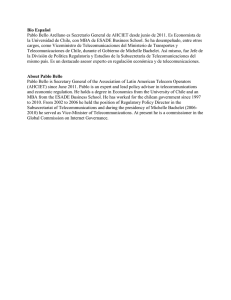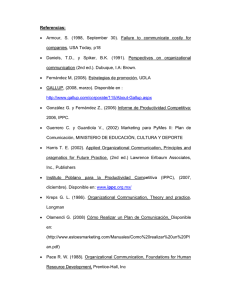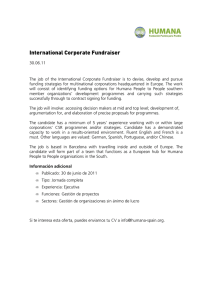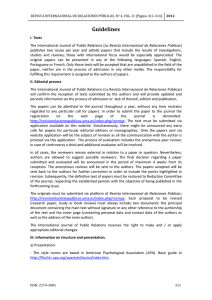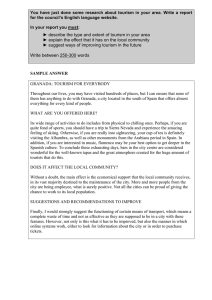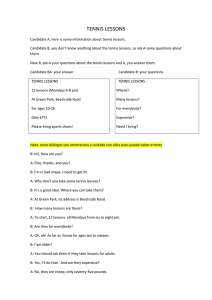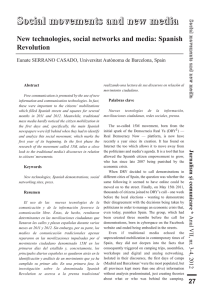Women and politics: The privacy without Necktie Mujeres y política
Anuncio
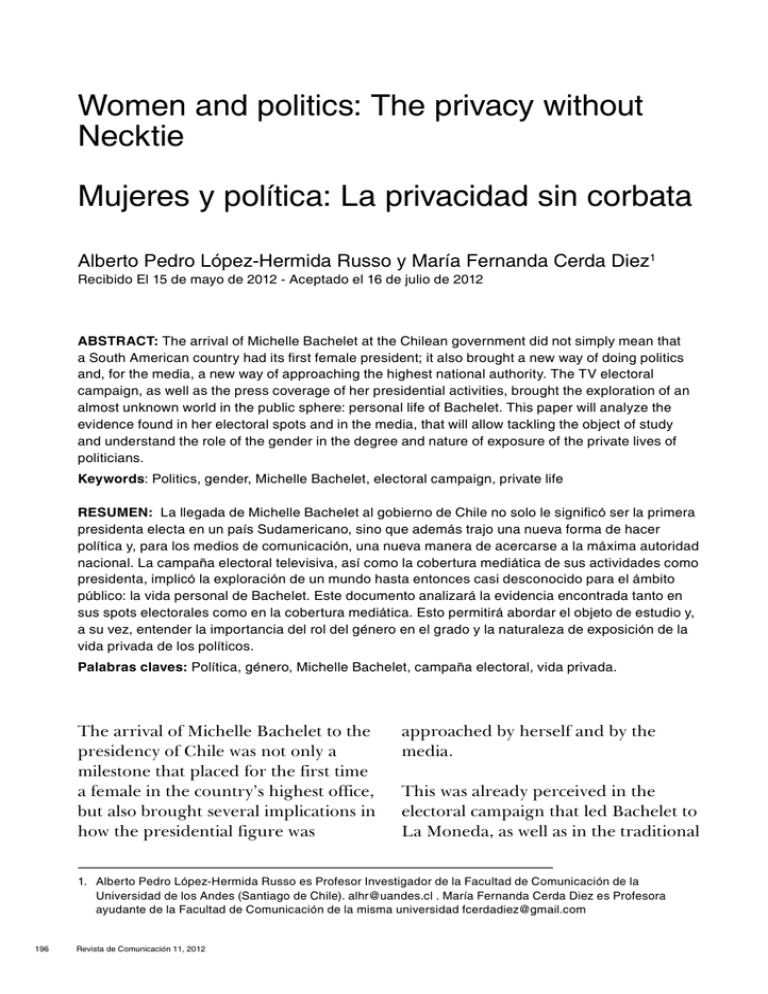
Women and politics: The privacy without Necktie Mujeres y política: La privacidad sin corbata Alberto Pedro López-Hermida Russo y María Fernanda Cerda Diez1 Recibido El 15 de mayo de 2012 - Aceptado el 16 de julio de 2012 ABSTRACT: The arrival of Michelle Bachelet at the Chilean government did not simply mean that a South American country had its first female president; it also brought a new way of doing politics and, for the media, a new way of approaching the highest national authority. The TV electoral campaign, as well as the press coverage of her presidential activities, brought the exploration of an almost unknown world in the public sphere: personal life of Bachelet. This paper will analyze the evidence found in her electoral spots and in the media, that will allow tackling the object of study and understand the role of the gender in the degree and nature of exposure of the private lives of politicians. Keywords: Politics, gender, Michelle Bachelet, electoral campaign, private life RESUMEN: La llegada de Michelle Bachelet al gobierno de Chile no solo le significó ser la primera presidenta electa en un país Sudamericano, sino que además trajo una nueva forma de hacer política y, para los medios de comunicación, una nueva manera de acercarse a la máxima autoridad nacional. La campaña electoral televisiva, así como la cobertura mediática de sus actividades como presidenta, implicó la exploración de un mundo hasta entonces casi desconocido para el ámbito público: la vida personal de Bachelet. Este documento analizará la evidencia encontrada tanto en sus spots electorales como en la cobertura mediática. Esto permitirá abordar el objeto de estudio y, a su vez, entender la importancia del rol del género en el grado y la naturaleza de exposición de la vida privada de los políticos. Palabras claves: Política, género, Michelle Bachelet, campaña electoral, vida privada. The arrival of Michelle Bachelet to the presidency of Chile was not only a milestone that placed for the first time a female in the country’s highest office, but also brought several implications in how the presidential figure was approached by herself and by the media. This was already perceived in the electoral campaign that led Bachelet to La Moneda, as well as in the traditional 1. Alberto Pedro López-Hermida Russo es Profesor Investigador de la Facultad de Comunicación de la Universidad de los Andes (Santiago de Chile). [email protected] . María Fernanda Cerda Diez es Profesora ayudante de la Facultad de Comunicación de la misma universidad [email protected] 196 Revista de Comunicación 11, 2012 Women and politics: The privacy without Necktie (196-211) press quotes about former President of Chile the days before and immediately after her election. This work – part of a more extensive research (López-Hermida, 2007) – analyzes Bachelet`s television campaign and their references about her private life as a candidate. Furthermore, a reference is made to aspects of the former minister private life, which have been known exclusively by the traditional media, meaning that the made known matter goes beyond a purely election. The objective of this analysis is somehow to establish whether the female condition of Bachelet as a candidate and later President stimulates the exposition of certain aspects of her private life. obtained from the press, in order to reach some conclusions. Intimacy, Public and Private Life From the standpoint of what potentially could be informed of the human person, the aristotelianthomistic tradition tends to distinguish between intimacy, private and public life. These three dimensions differ among them from a cultural point of view and shall not be considered as physically or mathematically separated. Moreover, they reflect the unity of the human person and they aim to be what gives to it anthropologically coherence (Soria, 1989). On one hand, the analysis of the TV spots is interesting since is in here where the candidate talks about herself, with no mediation. On the other hand, evidence provided by the media responds to a decision adopted by the same media in order to make these facts known. First, the intimacy only occurs in humans and it is immeasurable. It only may be object of information if, on one hand, its content is freely exteriorized by the individual and, on the other hand, if such disclosure has some degree of relevance for the community, i.e., if it is good for building up the community. Paradoxically, the information on any aspect of intimacy is the destruction of its own. First, we will distinguish between public, private and intimate life, following then with a presentation of some aspects that characterize the female politician. Then, after a presentation of the person of Michelle Bachelet, will be analyzed the campaign and the information Then, the privacy, dimension where the outside that connects the individual with the world begins, also cannot be communicated without restrictions. Initially, indeed, privacy is not an object of information, is radically excluded from the talkative. The only reason that can lead the Revista de Comunicación 11, 2012 197 Alberto Pedro López-Hermida Russo y María Fernanda Cerda Diez as a politician. media to provide known aspects of someone’s private life is the clear, direct and immediate link of the fact with the public. Finally, the public is what gives primary meaning to the public communication, as is the scope of the information itself. Community and communication are for this reason, closely linked. Corner (2000), outlining the politician public and private field, explicit an intersection between both, an area in which we can find out two phenomena: the strategic projection of private life in advertising, or in contrast, the media revelation of the public life as a matter of scandal or gossip. A wide range of authors (e.g. Soria, 1989; Sales, 1991; Corner, 2000) agree to allot to the private sphere what refers to the family, home, personal biography, friendships and hobbies. Parallel to this, what is public normally include everything related to, in the particular case of politicians, the party, the position they may take within an administration and any activity made That connection between public and private in political action is seen clearly in Van Zoonen and Holtzh-Bacha, when they speak about the personalization of politics (2000). The authors define four levels of customization, which are precisely between public and private language and a personal and political position (Figure 1). Figure1. Form and Degrees of Personalization ­ Language Personal Personal objectified discourse Political discourse Personal discourse Personalized political discourse Political Position Public Private Sources: Van Zoonen and Holtz-Bacha, 2000 Each of these quadrants represents a type of speech adopted by the 198 Revista de Comunicación 11, 2012 politician, which determines the degree of customization of the discourse. Women and politics: The privacy without Necktie (196-211) The degree called political discourse considers the politician speaking from a political position, for example, as a candidate. He uses a language of public domain. Then the personalized political discourse is the degree where the politician speaks from a political position, but with a language that is proper of the private sphere. Thirdly, the personal discourse consists in that degree in which the politician speaks as a private individual and in a language proper to the private sphere. Finally, the personal objectified discourse the politician speaks about public affairs from a private position. Applying this heuristic scheme allows a clear image of the personalized level that could use a politician during his electoral campaign or the one used during his administration. In the case of Michelle Bachelet, the application will allow seeing, the degrees of personalization she uses, but also, will throw the results about whether such personalization is done solely from her condition as a women. Thus, it may reaffirm in some way the idea according to which politician women collaborate on “transgress the rigid separation of public and private life” policies (Van Zoonen, 2006, 288). Before making such analysis, we need to clarify the deep differences that scientific research attributed between both genders when it comes to participate in politics. Peculiarities of being a Female Politician Several women have achieved the highest positions in their countries, even in conservative countries where women´s rights are restricted. There are many examples of women who have been leaders in their countries, as Sirimavo Bandaranaike in Sri Lanka, Indira Gandhi in India, Benazir Butto in Pakistan, Margaret Thatcher in England, Angela Merkel in Germany, Isabel Perón in Argentina, Violeta Chamorro in Nicaragua, Dilma Rousseff in Brazil and Michelle Bachelet in Chile, to name a few. Although the gender diversity in the highest leadership positions has increased in the past decades, women are dramatically underrepresented (Rosenthal, 2002; Duerst-Lathi, 2002). Statements like “the possibility of winning a political position is less for a woman than for a man” (Khan, 1993, 481) calls the interest of all kind of researchers, from the purely academic to the most committed to feminist causes court, and among whom it is sometimes very subtle difference, but not their goals. In 2004, Barbara Burrel concluded that citizens tend to apply gender stereotypes when personality traits and thematic expertise of each candidate appear. Revista de Comunicación 11, 2012 199 Alberto Pedro López-Hermida Russo y María Fernanda Cerda Diez Therefore, it may be perceived how a broad body of researches shows that depending on the candidate’s gender certain issues deem to be of his or her concern, independently of the career or references of the candidate in question. This is, in short, that there are certain subject areas in which male candidates are viewed more confortable, while other topics are easily identified with female candidates. On the other hand – and with the extra thematic issue –, the evidence also attributes certain traits in the personality of the male candidate, while others seem to be almost exclusively female. Political gender stereotypes stretch beyond character and leadership to issue concerns and perceptions of policy strengths, and male candidates again have the advantage. Various studies (e.g. Khan, 1993 and 1994, Iyengar, et.al. 1997; Kahn and Goldenberg, 1991; Huddy and Terkilsen, 1993a and 1993b; Alexander and Andersen, 1993; Sanbonmatsu, 2002; Burrel, 2004, Montgomery and Norton, 1981, Trent and Friedenberg, 1995; Banwart, 2010) attribute to the politician man, regarding thematic competition issues, a better managing than their female counterparts on issues like taxes, foreign policy, defense, economy, labor, agriculture and security. While female candidates involved in politics are often noted as being more capable in education, health social programs, seniors, 200 Revista de Comunicación 11, 2012 honesty, art, civil rights, family, environment and drugs control. Regarding the personality traits that are often attributed to men and women politicians, it outstands for men the independence, strong leadership, low emotionality, aggressiveness, toughness, ambition, and rationality. While female politicians are usually seen as dependants, weak leadership, highly emotional, compassionate and loving. Huddy and Terkildsen’s work (1993b) found that perceptions about issue expertise was linked to gender stereotypes about male and female candidates’ traits. Specifically, perceptions that a female candidate was more likely to possess traditionally feminine traits, such as sensitivity and warmth, related to perceptions of competency handling traditionally feminine issues, such as education and health care. Equally, perceptions of male candidates possessing stereotypically masculine traits, such as assertiveness and aggressiveness, related to the belief they were more competent to handle military and economic issues (Banwart, 2010). This division, seen from this point of view, is apparently more rigid than how it can really be, leads to think that, sometimes, female candidates “must display themselves atypical to the voters” (Huddy and Terkilsen, 1993a, 120), precisely to avoid being pigeonholed. Women and politics: The privacy without Necktie (196-211) To this end, female candidates may try to get rid of the negative stereotype by emphasizing masculine traits in their own campaigns, betting in a sort of backlash that materializes adopting a communication behaviour that violates the traditional view of female as deferential, soft and feminine. Judith S. Trent and Robert V. Friedenberg (1995,137) are very clear in stating that making this decision, the candidate “risks being seen as very aggressive, shrill, vicious, and scolded and bitch – in other words non feminine – who lost the benefits of being perceived as natural, warm and sensitive” . This option of breaking the “rules” is treated also by Leonie Huddy and Nada Terkilsen (1993b, 504) whom, in first place, demonstrate the existence of gender stereotypes precisely in the peculiarity that candidates do an effort adopting qualities proper to the other gender. Therefore, the presence of either trait or policy strength stereotypes undoubtedly poses greater obstacles in creating an electable image by requiring women to develop both an image of possessing the required male attributes for the job in concert with the expected – yet less valued – female attributes. Thus, when women do run, successfully employing select channels through which to develop an image and present a message are vital to the perceived viability of a candidate. The same authors added “in essence, women candidates will be successful in polls because they work to convince voters that, unlike women in general, they have the political strength of men”. It should be noted that, although at first seem to be only women who adopt masculine traits, is a fact that men opponents have become sympathetic and accessible, typical feminine traits. In short, “men and women candidates feel obliged to adopt positions or at least some traits typical of the other gender” (Huddy and Terkilsen, 1993a, 120). Made explicit the idea that, first, men and women involved in politics tend to be framed in a qualitative thematic very specific and different from each other. On the other side caused by the above, the policies seek to demonstrate masculine aspects, while the image of they have and vice versa, politicians too often just appear more “feminine” (López-Hermida, 2006). Bachelet Style Until 2004, the image of Michelle Bachelet Jeria was very low profile, as far as popularity is concerned. She was militant of the Socialist Party and was elected as Health Minister from the first day of Ricardo Lagos’s government. In January 2002 she was unexpectedly appointed as minister of Defense and marked several milestones: the first female to hold this position, the first socialist responsible for Defense since Revista de Comunicación 11, 2012 201 Alberto Pedro López-Hermida Russo y María Fernanda Cerda Diez the disturbed government of Salvador Allende, and also the daughter of Alberto Bachelet, general of the Chilean Air Force, dead in bizarre circumstances in a detention center, months after the military coup in 1973. Reviewing the troops military dressed, heading each September 19 the traditional military parade next to the President and knowing how to calm people down in the ever-present of the bustle issue of Human Rights, made that the popularity of the minister went up like foam. What possibly drew more media attention, voters and politicians, was called “Bachelet style”, which is reflected in several aspects. On the one hand, the independence that she showed in her tenure and then as minister and in her first decisions as president. On the other hand, toughness and discipline in taking decisions, and sometimes with that she addressed to her subordinates and colleagues. In parallel, she showed a high sensitivity, with high approximation to the citizens that led her to break regularly the protocol. Furthermore, the constant expression reflected in jokes and attitudes not accustomed by the quiet, shy and inhibited Chilean political class. 2005-06 TV Presidential Campaign An analysis of the television spots for Michelle Bachelet’s 2005-06 202 Revista de Comunicación 11, 2012 campaign shows that the former president of Chile used a total of 3 hours and 20 minutes of television time in her electoral spots, including the first round and the ballot, as did its closest opponent, Sebastian Piñera. In Chile, this time of broadcasting is free on both commercial and public stations. An examination of this space can be inferred in a first approximation, that Bachelet appeared on screen a 36.5% of the time, far from the 55% that Piñera was on stage. However, the voice of the Socialist candidate was heared, with or without her image, 49.5% of total time, two points more than it did her centreright opponent. It can be deducted in same analysis therefore, that Bachelet chose to speak off more and for shorter periods, while Piñera led long live monologues. Related to family – usually included within the intimacy – Sebastian Piñera showed a relative for nearly 6 minutes, while Michelle Bachelet, just for over 2 minutes. Quantitatively – therefore – the opposition candidate exhibited more this privacy side than the former president. However, to monitor the speeches of the election spots that led Michelle Bachelet to La Moneda and trying to find an evidence of the 4 levels of Women and politics: The privacy without Necktie (196-211) customization described by Zoonen and Holtzh-Bacha interesting conclusions can be drawn. First, for the level of political discourse, there are many examples, since the vast majority of the electoral promises are made from a political candidate side and with a public language: Figure 2. Examples of “Political Discourse” degree Speaking of fair wages: “I want equal wages between men and women” On crime: “Criminals do aware out: you will have only one chance in my government; you won’t have a second or a third...” In the labor area: “Let’s promote subsidies (for youngsters) for becoming involved in the labor market...” Related to Regional Policy: “I would like to give (to regions) legitimate tools in order to empower them to manage their own resources...” For small business: “I want incentives (to small and average industries), making easy credit access; I want them to be open to new technologies...” About teen pregnancy: “We must be ready for giving mother and child all the attention and care they need. We have to guarantee continuity in studies for young mothers...” About working mothers: “I wish that every working mother had access to a nursery...” “Let’s make a deal: Me as president will instruct that everyone has access to opportunities and you must take charge of making good use of them...” In all these examples, the personalization degree is low, meaning that Bachelet spoke to the voters in her status as candidate without personal references. This, despite the fact that in all the examples it is shown how Michelle Bachelet spoke in first person when she was president, both as plural and singular, which makes the text less impersonal, but consequently not less intimate or private. In the second level of personalization – personalized political discourse – the candidate maintains her political position but, unlike the above, with a private language itself. Thus, we find some examples: Revista de Comunicación 11, 2012 203 Alberto Pedro López-Hermida Russo y María Fernanda Cerda Diez Figure 3. Examples of “Personalized Political Discourse” degree On her life: “I knew I could do much more than protecting citizens from outside. I had in my hands the possibility of working to heal the deeper wound that divided my country... (the coup of 1973)”. On health: “You know me, I am a doctor. I know the issue of health from the inside. There comes to a point where the Isapres behavior is unacceptable” On education: “I was fortunate enough to study in an excellent high school in Chile and I also continue my education abroad. Today a young Chilean who makes the decision to burn their eye-lashes studying, knows that he is investing in a passport to became a citizen of the world” “I want to talk to those that didn’t vote for me because I am a woman ... we are used to do a double effort ... We have always give back 100% at home and at work ... and of course, not allowed to have a headache…” “Ultimately, a female President is a leader that doesn’t use a tie” Speaking from her status as candidate, it’s clear that Michelle Bachelet attempts to explain some aspect or even ask for votes with a language that references to her gender condition and her personal profession (prepolitical, calling it in some way), and no as her candidate circumstance. The third level of customization means that the position assumed by politicians is private and the language they use is also private. In this case, examples in the Bachelet’s election TV campaign are: Figure 4. Examples of “Personal Discourse” degree “They asked me to talk about my biography, but I think I am not going to show my ID card, nobody looks well in the picture...” “While thinking about choosing a career, I took a person to the Posta Central. When I saw the doctors, nurses, people waiting, giving themselves on to the other was for me a revelation. I felt the call...” “I am a Chilean, no less and no more, like millions of you. I work, I am in charge from my house and take my daughter to school...” “From my mother, Angela, archaeologist, I learned among many things that the past is a great book that if you know how to read it, you can better understand the present...” “My father, Alberto, military, (I learned) that the real battle is against all those things that do not leave us be who we want to be in peace and dignity...” 204 Revista de Comunicación 11, 2012 Women and politics: The privacy without Necktie (196-211) Can be demonstrated how the candidate makes speeches, beyond of the public sphere, taking elements of her private life. She used to be limited to mention her biographical data, stand out her position as a woman, as well as citizen and daughter. Obviously each intervention of this kind has a political purpose – its part of an advertising process – but only mentioning aspects commonly known as private. In the fourth level of customization, which involves a private position of the politician but with a public language, can be found some examples in the Michelle Bachelet election campaign. Figure 5. Examples of “Personal Objectified Discourse” degree When talking about women and labor: “Do you know why we tend to not recruit women? Because we get pregnant...” “Perhaps, ¿was I going to be pay less than President Lagos?” “We earn 30% less than men’s paycheck in an equal responsibility or position. Many times, we cannot work because we do not have personnel to leave our children with”. “We receive a smaller pension. We have no access in the same proportion than men to the best positions in companies and besides; we are in charge of our homes” In one situation, and later in the campaign, you can see her going in her car through the streets of Santiago, checking the everyday living of Chileans. At one point, her driver asks: Too tired? She responds with a resounding “No”. “Talking with my children I estimated that in the last 90 days I have visited hundreds of places and have met thousands of people...” “As a female and mother I know that there are social problems we have to face...” “I enjoy my city. Feeling safe… is not fair that the threat of crime is depriving our most basic liberties... I was Defence minister, I know what it takes to battle against crime”. In this point, the interest is focus in the fact that in the discourse structure Michelle Bachelet takes part personally in topics dealt publicly. Saying that “we get pregnant”, “we earn less” or “we get a smaller pension” endorses closely a public matter. Again using the condition of a female, she embraces causes, which are treated with an electoral vision. Furthermore, the benefit of these interventions is that their male counterparts could not do something similar; they are unable to take the same position in these matters. In figure 6 there are some examples taken from the four figures above, where Michelle Bachelet made the special emphasis on her gender. Is Revista de Comunicación 11, 2012 205 Alberto Pedro López-Hermida Russo y María Fernanda Cerda Diez important to make an emphasis that there are not few examples – remembering the van Zoonen and Holtzh-Bacha grids – of the inclusion of the entire private and personal spectrum en her speeches, leaving the purely political-public excluded. Precisely in this last degree, the candidate acted exclusively as itself, as done by her counterparts. The examples of the feminization of Bachelet’s speech, confirm what Corner (2000) said, where an intersection between the private and the public could respond to a strategic projection of private life in political advertising. Definitely, Michelle Bachelet used her gender condition to make her campaign – including her role as mother and daughter – which suggest quite clearly the effect it could have on the message is transmitted on the fact that a candidate is female. Figure 6. Examples of Gender emphasis in Private and Personal Spectrum “I want to talk to those that didn’t vote for me because I am a woman (...) we are used to do a double effort (...) We have always give back 100% at home and at work (...) and of course, not allowed to have a headache…” “Ultimately, a female President is a leader that doesn’t use a tie” “I am a Chilean, no less and no more, like millions of you. I work, I am in charge from my house and take my daughter to school...” When talking about women and labor: “Do you know why we tend to not recruit women? Because we get pregnant...” “Perhaps, ¿was I going to be pay less than President Lagos?” “We earn 30% less than men’s paycheck in an equal responsibility or position. Many times, we cannot work because we do not have personnel to leave our children with”. “We receive a smaller pension. We have no access in the same proportion than men to the best positions in companies and besides; we are in charge of our homes” “As a female and mother I know that there are social problems we have to face...” Media Coverage The action of the conventional media in front of the nomination and subsequent election of Michelle Bachelet was different when compared to their counterparts. While from private lives of men 206 Revista de Comunicación 11, 2012 candidates could be found little in the media, regarding Bachelet, when reviewing without much effort the press on days immediately before and after the election, it was known for example, that “with Sofia (her younger daughter) she walks the two family dogs and goes with Women and politics: The privacy without Necktie (196-211) her to the supermarket” (Qué Pasa, 21/1/2006). Bachelet herself told the newspaper some aspects of her private life, mentioning that her parents were “playful”; “her new house is spacious, good, but not a mansion. The important thing is that they are all very happy, although we have not finished unpacking many boxes ...” (Cosas, 30/9/2005). It was also learned that her daughters helped to prepare the food, call their children daily from a cell phone, only they know the number and that on the possibility of falling in love during her administration “I suspect I wouldn’t have the time for that”. Some articles, mainly from El Mercurio 29/1/2006, presented the affectionate curriculum of the new president, under the title “Presidential Loves”. It was fully detailed the relationships held with Jaime López, Jorge Dávalos, Alex Vojkovic and Aníbal Henríquez, needing to point out that for the first of her two marriages “she was dressed in a silk dress with wide Indian sleeves and varied colors, low heel shoes, little makeup, her hair loose, long and sleek, three long-stemmed roses”. On her role as mother, it was known that “she is a present and responsible parent” in a long interview with her daughter’s school inspector (La Segunda, 12/5/2006). Regarding the way she dresses the most graphic example is in the Cosas magazine interview, September 30, 2005, in the middle of her campaign where “in her tight agenda, the photo session ended up being a fun parenthesis of one and a half hours, where the former minister agreed to take out her inseparable eyeglasses”. She appeared so different in that magazine that the candidate herself clarified with humor that “is not photoshop” and that “many men tell me that I should go more often in that way” (El Mercurio, 3/10/2005). Media also informed that “she ought to use two-piece suits” while she was used to wear leotards when picking up her daughter from school; also “they convinced her to let her hair grow (...) Bachelet also dropped weight (...) lost almost 8 pounds and now she has reduced two sizes” (Qué Pasa, 21/1/2006). This, on one hand, could be tolerated with the certainty that other men candidates were political figures already known. However, information about their romances was never published, nor their daily schedule in family privacy, even details on how they were dressed on the day of their marriage or their weight loss. Evidently, looking at the written media, the fact of being a female collaborated in the press interest for knowing private information and Revista de Comunicación 11, 2012 207 Alberto Pedro López-Hermida Russo y María Fernanda Cerda Diez candidate’s intimate moments, later president of Chile. Few times in the South American country, private issues of politicians were presented, like the ones above exposed, and may occur effectively in other countries (Street , 2000) on the UK case). Perhaps the most significant case – when was less than a year for Bachelet to leave La Moneda – were the photographs taken to the president swimming in a Brazilian beach in December 2008. On the other hand, media also highlighted and made known to the public opinion, Bachelet’s private life – love and family mainly. The gender biases are still present in media coverage that emphasizes female candidate appearance, gender, and marital status. Although in 2003 former President Lagos was also photographed in swimsuit bathing this time in Chañaral in an effort to demonstrate the cleanliness of the water, in Bachelet’s case, to a greater or lesser extent, was such the impact that all newspapers next morning covers, emphasized in the swimming. Regardless this fact occurred at 6 am, before the starting of meetings of the Latin America and the Caribbean Summit, in an absolutely private activity of the president; other country leaders, at the same time went swimming, and this fact was absolutely not mentioned. Clearly, this does not answer any kind of political strategy, because we talk about the mediation the same media exercised in the arrival of a female to the Presidency. There is, rather, an editorial decision by the media to consider certain private and intimate information about Bachelet as news. Conclusions Unlike other women in high responsibility positions like Angela Merkel and Tarja Halonen – “both women are reticent about opening up their private personae to the scrutiny of the media and public” (van Zoonen, 2006, 297) – Bachelet bet to reveal part of her privacy and she has not Primarily, in the presidential campaign, Michelle Bachelet exposed parts of her private live. In addition, she generally did so emphasizing in her woman, mother and daughter condition. 208 The foregoing confirms a strategy in behalf of the candidate to make her electoral spicier message with the exceptional fact that in Chile a female – like a mother and a daughter – was a candidate. Revista de Comunicación 11, 2012 So overall, we can say that being a woman has allowed both the candidate and the media to illuminate private aspects, both like an electoral strategy and by an editorial decision, respectively. Women and politics: The privacy without Necktie (196-211) opposed, even she has cooperated with the media to transmit. Certainly, it would be very interesting to determine whether that conducts of a woman politician like Michelle Bachelet continuous if it returns to run for president of Chile, as it is possible to happen in the elections to be held in that country in 2013. References Alexander, Deborah y Andersen, Kristi (1993), “Gender as a Factor in the Attribution of Leadership Traits”, Political Research Quarterly, vol.46 (3), 527-545. Banwart, Mary Christine (2010). “Gender and candidate Communication: Effects of Stereotypes in the 2008 Election”. American Behavioral Science. 265-283. Burrel, Barbara (2004), Women and Political Participation: A reference handbook, ABC-CLIO, Santa Barbara. Corner, John (2000), “Mediated persona and political culture: Dimensions of structure and process”, European Journal of Cultural Studies, vol.3, 386-402. Duerst-Lanthi, Georgia (2002). “Knowing Congress as a gendered institution: Manliness and the implications of women in Congress”. In Women transforming Congress, ed. Cindy Simon Rosenthal, 20-49. Norma: University of Oklahoma Press. Huddy, Leonie and Terkilsen, Nayda (1993a), “Gender Stereotypes and the Perception of Male and Female Candidates”, American Journal of Political Science, vol.37 (1), 119-147. Huddy, Leonie and Terkilsen, Nayda (1993b), “The Consequences of Gender Stereotypes for Women Candidates at Different Levels and Types of Office”, Political Research Quarterly, vol. 46 (3), 503-525. Iyengar, Shanto; Valentino, Nicholas; Ansolabehere, Stephen and Simon, Adam (1997), “Running as a Woman: Gender Stereotyping in Political Campaigns” in Norris, Pippa (ed.), Women, media, and politics, New York: Oxford University Press. Kahn, Kim F. and Goldenberg, Edie N. (1991), “Women candidates in the news: An examination of gender differences in U.S. Senate campaign coverage”, The Public Opinion Quarterly, vol.55, 2, 180-199. Revista de Comunicación 11, 2012 209 Alberto Pedro López-Hermida Russo y María Fernanda Cerda Diez Khan, Kim F. (1993), “Gender differences in campaign messages: The political advertisements of men and women candidates for U.S. Senate”, Political Research Quarterly, vol.46 (3), 481-502. Khan, Kim F. (1994), “Does Gender Make a Difference? An Experimental Examination of Sex Stereotypes and Press Pattern in Statewide Campaigns”, American Journal of Political Science, vol. 38 (1), 162-195. KAID, Linda Lee et all (2004). Gender and Candidate Communication: VideoStyle, WebStyle, and NewStyle. New York: Routledge. López-Hermida, Alberto (2006), “Mujeres al poder: la reivindicación de los estereotipos”, Nuevas Tendencias, vol. 62, 3-14. López-Hermida, Alberto (2007), El estereotipo de género en política. La imagen de la mujer candidata en las elecciones presidenciales chilenas 2005-06 y su continuidad en el primer año de gobierno de Michelle Bachelet, doctoral thesis, Universidad de Navarra, Spain. Montgomery, Barbara and Norton, Robert (1981), “Sex differences and similarities in communicator style”, Communication Monographs, vol. 48 (2), 121-132. Rosenthal, Cindy Simon (2002). Women transforming Congress. Norma: University of Oklahoma Press. Sales, Arnaud (1991), “The Private, the Public and Civil Society: Social Realms and Power Structures”, International Political Science Review, vol.12, 295-312 Sanbonmatsu, Kira (2002), “Gender Stereotypes and Vote Choice”, American Journal of Political Science, vol. 46 (1), 20-34. Soria, Carlos (1989), “La información de lo público, lo privado y lo íntimo”, Cuenta y Razón del Pensamiento Actual vol. 44-45, 25-30. Street, John (2000), “Prime time politics”: Popular culture and politicians in the UK, Javnost the public, vol.7 (2), 75-90. Trent, Judith and Friedenberg, Robert (1995), Political Campaign Communication: Principles and Practices, Preager, Westport. van Zoonen, Liesbet (2006), “The personal, the political and the popular: A woman`s guide to Celebrity politics”, European Journal of Cultural Studies, vol.9, 287-301. 210 Revista de Comunicación 11, 2012 Women and politics: The privacy without Necktie (196-211) van Zoonen, Liesbet (2000), “Popular culture as political Communications”, Javnost the public, vol.7 (2), 5-18. van Zoonen, Liesbet and Holtzh-Bacha, Christina (2000), “Personalisation in Dutch and German politics: The case of the talk show”, Javnost the public, vol.7 (2), 45-56. Revista de Comunicación 11, 2012 211
